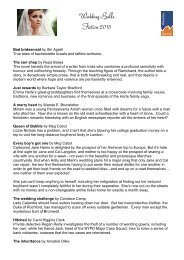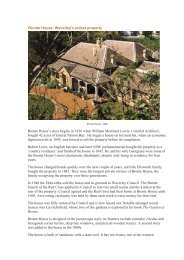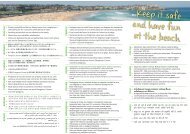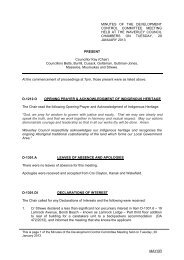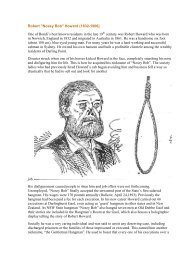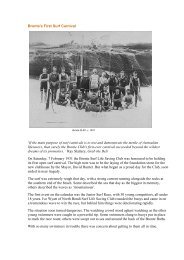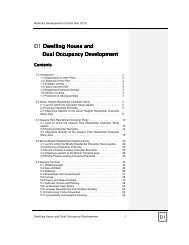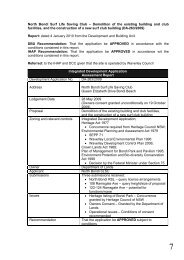Annual Report 2005-2006 - Waverley Council
Annual Report 2005-2006 - Waverley Council
Annual Report 2005-2006 - Waverley Council
Create successful ePaper yourself
Turn your PDF publications into a flip-book with our unique Google optimized e-Paper software.
90<br />
<strong>Waverley</strong> <strong>Council</strong><br />
Meeting Our Statutory Requirements<br />
The following information is provided in accordance with the annual reporting requirements outlined in<br />
Section 428(2) of the Local Government Act 1993.<br />
a. Statement of Expenses, Revenue and Assets<br />
This information can be found in <strong>Council</strong>’s Financial <strong>Report</strong>, which begins on page 121.<br />
b. Actual and Projected Performance Comparison<br />
This can be found in Section Two – Reviewing Our <strong>2005</strong>/2009 Management Plan beginning on page<br />
18.<br />
c. State of The Environment – How Are We Going?<br />
(Also see pages 156 – 178 and our separate State of The Environment <strong>Report</strong> <strong>2006</strong>)<br />
In our State of the Environment <strong>Report</strong> a number of environmental indicators have been included to<br />
help assess how <strong>Council</strong>, other government agencies and the community are looking after the<br />
environment and working towards the goal of ecologically sustainable development (ESD). As it is<br />
impossible to accurately assess when a community has achieved the right environmental and<br />
economic balance, indicators can show whether we are heading in the right direction. They can also<br />
be used as a report card to assess <strong>Council</strong>'s performance in the years ahead.<br />
The indicators that are used have met the following criteria:<br />
they reflect something fundamental to the long term economic, environmental or social health of the<br />
community;<br />
they are statistically measurable — either the data exists or a practical method of data collection can<br />
be created;<br />
the indicator represents something that can be influenced by the community or government actions.<br />
The indicators that have been chosen are by no means exhaustive, nor cover every environmental,<br />
economic or social consideration. However, they provide the starting point for <strong>Council</strong>'s environmental<br />
program. Each year government agencies suggest a suite of indicators for councils and other<br />
agencies to use. Only some of these are included in this report because <strong>Council</strong> could spend all its<br />
time and resources collecting information on the state of and pressures impacting on the environment<br />
rather than acting to protect it.<br />
The indicators chosen are listed below. For each indicator progress in the current year against the<br />
base year 2001/2002 is shown unless relevant data or other information was unavailable. The last<br />
column shows our movement toward sustainability compared with the baseline figures.<br />
Sustainability Indicator 2001/2002 <strong>2005</strong>/<strong>2006</strong> Movement toward<br />
sustainability<br />
Total tonnes waste to landfill<br />
(no recycling)<br />
17,924 16,958 <br />
Total tonnes waste to<br />
recycling<br />
6,873 10,493.9 <br />
Tonnes of illegally dumped<br />
rubbish removed by <strong>Council</strong><br />
250 634.6 <br />
<strong>Annual</strong> <strong>Report</strong> <strong>2005</strong>//<strong>2006</strong>



